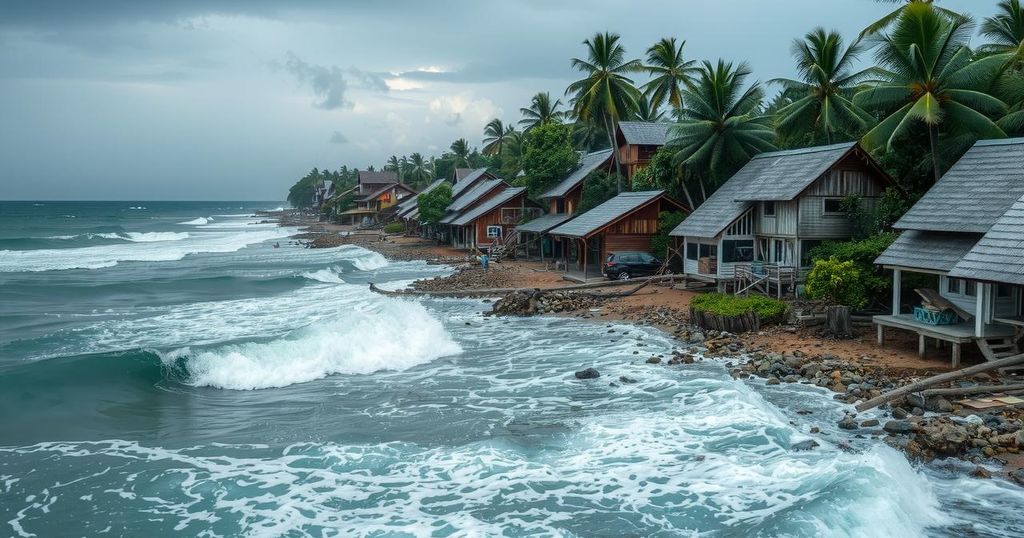Weather
World news
AFRICA, ASIA, BANDA ACEH, BURMA, DAT, DEATH TOLL, EARTHQUAKES, EL NINO, EM, EM - DAT, FLOODS, INDIA, INDIA PLATE, INDIAN OCEAN, INDONESIA, JAPAN, MALAYSIA, MALDIVES, MYANMAR, NATURAL DISASTERS, NORTH AMERICA, OCEAN, PACIFIC, PACIFIC BASIN, RING OF FIRE, SOMALIA, SOUTHEAST ASIA, SRI LANKA, SUMATRA, THAILAND, UNITED STATES, UNITED STATES GEOLOGICAL SURVEY
Sofia Rodriguez
0 Comments
Reflecting on the 2004 Indian Ocean Tsunami: 20 Years Later
Survivors and families mark the 20th anniversary of the devastating 2004 Indian Ocean tsunami, which resulted in over 220,000 deaths across multiple nations. Triggered by a 9.1-magnitude earthquake, it was one of the most catastrophic natural disasters in history, prompting significant international relief efforts and improvements in tsunami preparedness.
This week, survivors and relatives of victims will commemorate the 20th anniversary of the 2004 Indian Ocean earthquake and tsunami, a catastrophic event that resulted in over 220,000 fatalities across more than a dozen nations. Triggered by a 9.1-magnitude earthquake off the western coast of Sumatra, Indonesia, colossal waves inundated coastal regions of countries including Sri Lanka, India, and Thailand. The earthquake was the longest faultline rupture observed, occurring seconds before 7:59 AM on December 26, 2004, and the resultant waves reached heights in excess of 30 meters (100 feet). The energy released was equivalent to 23,000 Hiroshima atomic bombs, leading to widespread devastation.
The tsunami claimed the lives of 226,408 individuals, with northern Sumatra being the hardest hit, as more than 120,000 residents perished out of a total of 165,708 fatalities recorded in Indonesia. The waves traveled at astonishing speeds of over 800 kilometers per hour (500 mph), impacting areas such as Sri Lanka, India, and Thailand within hours. Notably, over 35,000 deaths occurred in Sri Lanka, with India experiencing 16,389 fatalities and Thailand 8,345. Additional casualties were reported in Somalia, the Maldives, Malaysia, and Myanmar, further extending the tragedy’s reach.
The disaster displaced over 1.5 million people and mobilized approximately $14 billion in international disaster relief efforts. In the aftermath, significant reconstruction efforts transpired, particularly in Banda Aceh, where over 100,000 homes were rehabilitated. Furthermore, the tsunami prompted a critical evaluation of coastal preparedness, as no early warning systems were in place at the time of the earthquake. This led to the establishment of a global network of 1,400 monitoring stations, reducing warning times to mere minutes. Although significant advancements have been achieved in tsunami preparedness, experts assert that the potential impact of catastrophic tsunamis can never be entirely mitigated.
The 2004 Indian Ocean tsunami is considered the deadliest tsunami in recorded history, having devastating effects on multiple countries situated around the Indian Ocean. The preceding seismic event was a 9.1-magnitude earthquake, making it one of the most powerful earthquakes ever documented. The ramifications of this disaster catalyzed improvements in tsunami preparedness, including the advent of warning systems which significantly enhance response times to such catastrophic wave events. The 20th anniversary offers a poignant reflection on the lasting impacts and advancements in disaster management procedures since the tragedy.
The 20th anniversary of the 2004 Indian Ocean tsunami serves as a stark reminder of the catastrophic loss of life and widespread destruction caused by natural disasters. Since then, enhancements in tsunami warning systems and international disaster response have improved preparedness, yet the risk of massive tsunamis remains. Continuous investment and vigilance are necessary to minimize potential harm from future seismic events, underscoring the importance of global collaboration in disaster risk reduction.
Original Source: www.france24.com




Post Comment